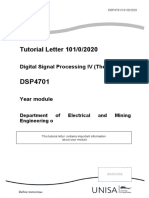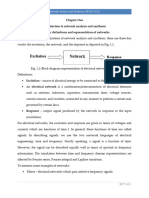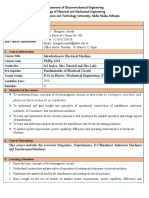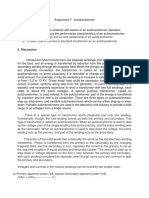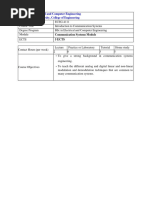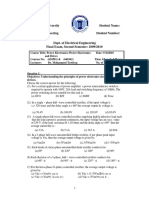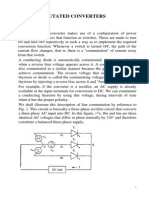UNIT3
UNIT3
Uploaded by
Azliana Mohd TaibCopyright:
Available Formats
UNIT3
UNIT3
Uploaded by
Azliana Mohd TaibCopyright
Available Formats
Share this document
Did you find this document useful?
Is this content inappropriate?
Copyright:
Available Formats
UNIT3
UNIT3
Uploaded by
Azliana Mohd TaibCopyright:
Available Formats
REGISTER
E2064/3/1
Unit 3
REGISTER
E2064/3/2
UNIT 3
Register
OBJECTIVES
General Objective
Know and apply the fundamental concepts of the register .
Specific Objectives
At the end of this unit, you should be able to:
draw a basic shift register circuit using JK flip-flop and D flip-flop describe the basic function of the register identify the basic forms of data movement in shift registers list the types of shift register describe the operation of serial in/serial out(SISO), serial in/parallel out(SIPO), parallel in/serial out(PISO), and parallel in/parallel out(PIPO) shift registers state the applications of shift register in arithmetic operations; division and multiplication. construct a ring counter from a shift register state the application of shift register IC
REGISTER
E2064/3/3
INPUT INPUT
3.0 INTRODUCTION
Shift registers are a type of sequential logic circuit, mainly for storage of digital data. They are a group of flip-flops connected in a chain so that the output from one flip-flop becomes the input of the next flip-flop. Most of the registers possess no characteristic internal sequence of states. All the flip-flops are driven by a common clock, and all are set or reset simultaneously. A typical example of a shift register at work is found within a calculator. As you enter each digit on the keyboard, the numbers shift to the left on the display. In other words, to enter the number 156 you must do the following. First, you press and release the 1 on the keyboard; a 1 appears at the extreme right on the display. Next, you press and release the 5 on the keyboard causing the 1 to shift one place to the left allowing for 5 to appear on the extreme right; 15 appears on the display. Finally, you press and release the 6 on the keyboard; 156 appears on the display. This example shows two important characteristics of shift registers: (i) It is a temporary memory and thus holds the numbers on the display (even if you release the keyboard number) and (ii) it shifts the numbers to the left on the display each time you press a new digit on the keyboard. These memory and shifting characteristics make the shift register extremely valuable in most digital electronic systems. In this unit, we are going to learn the basic types of shift registers, such as Serial In - Serial Out, Serial In - Parallel Out, Parallel In - Serial Out, Parallel In Parallel Out, and bidirectional shift registers. A special form of counter - the shift register counter, is also introduced.
REGISTER
E2064/3/4
3.1 Basic Shift Register Circuit
A register is a digital circuit with two basic functions: data storage and data movement. The storage capability of a register makes it an important type of memory device. Figure 3.1 illustrates the concept of storing a 1 or a 0 in a D flipflop. A 1 is applied to the data input as shown, and a clock pulse is applied that stores the 1 by setting the flip-flop. When the 1 on the input is removed, the flipflop remains in the SET state, thereby storing the 1. The same procedure applies to the storage of a 0, as also illustrated in Figure 3.1.
" 1 " is s to r e d "1 " C LK
Q Q
" 0 " is s t o r e d "0 " C LK
Q Q
Figure 3.1: The flip-flop as a storage element
REGISTER
E2064/3/5
The storage capacity of a register is the number of bits (1s and 0s) of digital data it can retain. Each flip-flop in a shift register represents one bit of storage capacity; therefore, the number of flip-flops in a register determines its total storage capacity. For example, if 2 bit shift register to be built, 2 flip-flops are needed, as illustrated in Figure 3.2.
D a ta in p u t
D
C LK
D a ta o u t
Q Q
0
Q Q
Figure 3.2: A 2-bit shift register
REGISTER
E2064/3/6
3.2
Shift Register Using Flip-Flops
The flip-flops used to construct registers are usually either JK or D types.
So, lets begin by summarizing the operation of a D flip-flop.
3.2.1 Shift Register Using D Flip-Flop
A basic four-bit shift register can be constructed using four D flip-flops, as shown in Figure 3.3. The operation of the circuit is as follows.
Figure 3.3: A 4-bit shift register
On the leading edge of the first clock pulse, the signal on the DATA input is latched in the first flip-flop. On the leading edge of the next clock pulse, the contents of the first flip-flop is stored in the second flip-flop, and the signal which is present at the DATA input is stored in the first flip-flop, etc. Because the data is entered one bit at a time, it is called a serial-in shift register. Since there is only one output, and data leaves the shift register one bit at a time, then it is also a serial out shift register. (Shift registers are named by their method of input and output; either serial or parallel). Parallel input can be provided through the use of the preset and clear inputs to the flip-flop. The parallel loading of the flip-flop can be synchronous ( i.e., occurs with the clock pulse) or asynchronous (independent of the clock pulse) depending on the design of the shift register.
REGISTER
E2064/3/7
3.2.2 Shift Register Using JK Flip-Flop
For a JK flip-flop, the data bit to be shifted into the flip-flop must be present at the J and K inputs when the clock transitions (low or high). Since the data bit is either a 1 or a 0, there are two cases: iiiTo shift a 0 into the flip-flop, J = 0 and K = 1. To shift a 1 into the flip-flop, J = 1 and K = 0.
The important point to note is that the J and K inputs must be controlled to provide the correct input data. The J and K logic levels may be changing while the clock is high (or low), but they must be steady from just before until just after the clock transition. For our discussion, we shall use JK master-slave flip-flops having clock inputs that are sensitive to negative clock transitions. Incidentally, this negative transition of the clock is frequently referred to as a shift pulse. The waveforms in Figure 3.4 illustrate these ideas. At time A, Q is reset low (a 0 is shifted into the flip-flop). At time B, Q does not change since the flipflop had a 0 in it and another 0 is shifted in. At time C, the flip-flop is set (a 1 is shifted into it). At time D, another 0 is shifted into the flip-flop. In essence, we have shifted 4 data bits into this flip-flop in a time sequence: a 0 at time A, another 0 at time B, a 1 at time C, and a 0 at time D.
REGISTER
E2064/3/8
Input data Clock (shift)
J K
SET
Q Q
CLR
Figure 3.4: Shift register using JK flip-flop
Figure 3.5: Timing diagram of the shift register
REGISTER
E2064/3/9
3.3 Types Of Register
The bits in a binary number (lets call them the data) can be moved from one place to another in either of two ways. The first method involves shifting the data 1 bit at a time in a serial fashion, beginning with either the most significant bit (MSB) or the least significant bit (LSB). The technique is referred to as serial shifting. The second method involves shifting all the data bits simultaneously and is referred to as parallel shifting. There are two ways to shift data into a register (serial or parallel) and similarly two ways to shift the data out of the register. This leads to the construction of four basic register types as shown in Figure 3.6: serial in/serial out (SISO), serial in/parallel out (SIPO), parallel in/serial out (PISO), and parallel in/parallel out (PIPO). All of these configurations are commercially available as TTL MSI/LSI circuit.
Parallel data input MSB Serial data input Serial data output LSB
SISO
PISO
Serial data output
Parallel data input Serial data input MSB LSB
SIPO
PIPO
MSB LSB Parallel data output MSB LSB
Parallel data output Figure 3.6: Shift Register types
REGISTER
E2064/3/10
3.3.1 Serial In/ Serial Out Shift Register
The serial in/serial out shift register accepts data serially, that is, one bit at a time on a single line. It produces the stored information on its output also in serial form. Lets first look at the serial entry of data into a typical shift register. Figure 3.7 shows a 4-bit device implemented with D flip-flops. With four stages, this register can store up to four bits of data; its storage capacity is four bits.
FF0 FF1 FF2 FF3
s e r ia l d a ta in p u t
Q Q
Q Q
Q Q
Q Q
s e r ia l d a ta o u tp u t
C LK Figure 3.7: Serial in/serial out register
Figure 3.8 illustrates entry of the four bits 1010 into the register, beginning with the right-most bit. The register is initially clear. The 0 is put into the data input line, making D = 0 for FF0. When the first clock pulse is applied, FF0 is RESET, thus storing the 0. Next the second bit, which is a 1, is applied to the data input, making D = 1 for FF0 and D = 0 for FF1 because the D input of FF1 is connected to the Q 0 output. When the second clock pulse occurs, the 1 on the data input is shifted into FF0 because FF0 sets, and the 0 that was in FF0 is shifted into FF1. The third bit, a 0, is now put onto the data-input line, and a clock pulse is applied. The 0 is entered into FF0, the 1 stored in FF0 is shifted into FF1, and the 0 stored in FF1 is shifted into FF2.
REGISTER
E2064/3/11
REGISTER
E2064/3/12
The last bit, a 1, is now applied to the data input, and a clock pulse is applied. This time the 1 is entered into FF0, the 0 stored in FF0 is shifted into FF1, the 1 stored in FF1 is shifted into FF2, and the 0 stored in FF2 is shifted into FF3. This completes the serial entry of the four bits into the shift register, where they can be stored for any length of time as long as the flip-flops have DC power.
FF0 D a ta in p u t
D
SET
FF1
Q Q
0
FF2
Q Q
0
FF3
Q Q
0
SET
SET
SET
Q Q
CLR
C LR
CLR
CLR
R e g is t e r in it ia lly C LEAR
C LK
1 s t d a t a b it = 0
SET
Q Q
SET
Q Q
SET
Q Q
SET
Q Q
A fte r C L K 1
CLR
C LR
CLR
CLR
C LK1
2 n d d a t a b it = 1
SET
Q Q
SET
Q Q
SET
Q Q
SET
Q Q
A fte r C L K 2
CLR
C LR
C LR
C LR
C LK2
0
3 rd d a t a b it = 0
SET
Q Q
SET
Q Q
SET
Q Q
SET
Q Q
A fte r C L K 3
CLR
C LR
C LR
C LR
C LK3
4 th d a t a b it = 1
SET
Q Q
SET
Q Q
SET
Q Q
SET
Q Q
A fte r C L K 4
CLR
C LR
C LR
C LR
C LK4
t h e 4 - b it n u m b e r i s c o m p le t e ly s t o r e d in r e g i s t e r
Figure 3.8: Four bits (1010) being entered serially into the register
REGISTER
E2064/3/13
If you want to get the data out of the register, the bits must be shifted out serially and taken off the Q3 output, as Figure 3.9 illustrates. After CLK4 in the data entry operation just described, the right-most bit, 0, appears on the Q 3 output. When clock pulse CLK5 is applied, the second bit appears on the Q 3 output. Clock pulse CLK6 shifts the third bit to the output, and CLK7 shifts the fourth bit to the output. Notice that while the original four bits are being shifted out, more bits can be shifted in. As shown in Figure 3.9, all zeros are being shifted in.
FF0 0
D
SET
FF1
Q Q
1
FF2
Q Q
0
FF3
Q Q
1
SET
SET
SET
Q Q
Q 3 1 st d a ta b it
A fte r C L K 4 , re g i ste r c o n ta in s 1 0 1 0
C LR
C LR
C LR
C LR
C LK
SET
Q Q
SET
Q Q
SET
Q Q
SET
Q Q
Q 3 2 n d d a ta b it A fte r C L K 5
C LR
C LR
C LR
C LR
C LK 5
SET
Q Q
SET
Q Q
SET
Q Q
SET
Q Q
Q 3 3 rd d a ta b it A fte r C L K 6
C LR
C LR
C LR
CLR
C LK6
0
SET
Q Q
SET
Q Q
SET
Q Q
SET
Q Q
4 th d a ta b it
C LR C LR C LR CLR
A fte r C L K 7
C LK7
SET
Q Q
SET
Q Q
SET
Q Q
SET
Q Q
3 A fte r C L K 8 , re g is te r is C L E A R
C LR
C LR
C LR
CLR
C LK8
t h e 4 - b it n u m b e r is c o m p le t e ly s t o r e d in r e g is t e r
Figure 3.9: Four bits (1010) being serially shifted out of the register and replaced by all zeros.
REGISTER
E2064/3/14
Example 3.1 Draw the waveforms to shift the number 0100 into the shift register shown in the figure below.
s e r ia l d a ta in p u t Q
0
Q Q
Q Q
Q Q
Q Q
d a ta o u t
C LK
Solution to Example 3.1
C LK
REGISTER
E2064/3/15
3.3.2 Serial In/ Parallel Out Shift Register
The second type of register mentioned in section 3.3 is one in which data is shifted in serial, but shifted out in parallel. Once the data are stored, each bit appears on its respective output line, and all bits are available simultaneously, rather than on a bit by bit basis as with the serial output. Figure 3.10 shows a 4bit serial in/parallel out shift register and its logic block symbol.
FF0 d a ta in p u t FF1 FF2 FF3
Q Q
Q Q
Q Q
Q Q
C LK Q Q Q Q
(a)
(b)
d a ta in p u t C LK
SRG 4
Figure 3.10: (a) Serial in/Parallel out shift register (b) Symbol Logic
Suppose that the data input is to be loaded in this 4-bit register is 0110. Since the 4-bit data is fed serially, the 4 clock pulses are needed to shift the data into the register. The data may now be read from the four Q outputs of the flipflops.
REGISTER
E2064/3/16
3.3.3 Parallel In/ Serial Out Shift Register
For a register with parallel data inputs, the bits are entered simultaneously into their respective stages on parallel lines rather than on a bit-by-bit basis on one line as with serial data inputs. The serial output is the same as described in section 3.3.1, once the data are completely stored in the register. Figure 3.11 illustrates a 4-bit parallel in/serial out shift register.
Notice that there are four data-input lines, D 0, D1, D2, and D3, and a
SHIFT/ LOAD
input, which allows four bits of data to be loaded in parallel into
SHIFT/LOAD
the register. When
is LOW, gates G1 through G3 are enabled,
allowing each data bit to be applied to the D input of its respective flip-flop. When a clock pulse is applied, the flip-flops with D = 1 will SET and those with D = 0 will RESET, thereby storing all four bits simultaneously. When is HIGH, gate G1 through G3 are disabled and gates
SHIFT/ LOAD
G4 through G6 are enabled, allowing the data bits to shift right from one flip-flop to the next. The OR gates allow either the normal shifting operation or the parallel data-entry operation, depending on which AND gates are enabled by the level on the
SHIFT/ LOAD
input.
Example 3.2
REGISTER
E2064/3/17
Show the data-output waveform for a 4-bit register with the parallel input data and the clock and
SHIFT/ LOAD
waveforms given in figure below, if the parallel
data are D0 D1 D2 D3 = 1010.
D0 1 D1 D2 0 1 D 0
3
S H IF T / L O A D CLK
SRG 4 D a ta o u t (Q 3)
Solution to Example 3.2
CLK
S H IF T / L O A D
D a ta o u t (Q 3)
REGISTER
E2064/3/18
3.3.4 Parallel In/ Parallel Out Shift Register
For parallel in/parallel out shift registers, all data bits appear on the parallel outputs immediately following the simultaneous entry of the data bits. The following circuit in Figure 3.12 is a four-bit parallel in/parallel out shift register constructed by D flip-flops.
Figure 3.12: A 4-bit parallel in/parallel out shift register
The D's are the parallel inputs and the Q's are the parallel outputs. Once the register is clocked, all the data at the D inputs appear at the corresponding Q outputs simultaneously.
3.3.5 Bidirectional Register
A bidirectional shift register is one in which the data can be shifted either left or right. It can be implemented by using gating logic that enables the transfer of a data bit from one flip-flop to the next flip-flop to the right or to the left, depending on the level of a control line. A 4-bit bidirectional shift register is shown in Figure 3.13. A HIGH on the RIGHT/LEFT control input allows data bits inside the register to be shifted to the right, and a LOW enables data bits inside the register to be shifted to the left. An examination of the gating logic will make the operation apparent. When the RIGHT/LEFT control input is HIGH, gates G1 through G4 are enabled, and the state of the Q output of each flip-flop is passed through to the D input of the
REGISTER
E2064/3/19
following flip-flop. When a clock pulse occurs, the data bits are shifted one place to the right. When the RIGHT/LEFT control input is LOW, gates G 5 through G8 are enabled, and the Q output of each flip-flop is passed through to the D input of the preceding flip-flop. When a clock pulse occurs, the data bits are then shifted one place to the left.
Figure 3.13: A 4-bit bidirectional shift register
REGISTER
E2064/3/20
Example 3.3 Determine the state of the shift register of Figure 3.13 after each clock pulse for the given
RIGHT/ LEFT
control input waveform in figure below. Assume
that Q0 = 1, Q1 = 1, Q2 = 0, and Q3 = 1 and the serial data-input line is LOW. Solution to Example 3.3
R I G H T /LEFT LEFT RIGHT/
( rig h t )
( le ft )
( rig h t )
( le ft )
CLK
Q 0
Q 1
Q 2
Q 3
The key to everything is patience. You get the chicken by The key to everything is patience. You get the chicken by hatching the egg, not by smashing it. hatching the egg, not by smashing it. - Arnold H. Glasow - Arnold H. Glasow
REGISTER
E2064/3/21
Activity 3A
LETS TRY TO ANSWER THE QUESTIONS BELOW..! 3.1 A stage in a shift register consists of (a) a latch (c) a byte of storage 3.2 (b) a flip-flop (d) four bits of storage
To serially shift a byte of data into a shift register, there must be (a) one clock pulse (c) eight clock pulses (b) one load pulse (d) one clock pulse for each 1 in the data
3.3
To parallel load a byte of data into a shift register, there must be (a) one clock pulse (c) eight clock pulses (b) one clock pulse for each 1 in the data (d) one clock pulse for each 0 in the data
3.4
The group of bits 10110101 is serially shifted (right-most bit first) into an 8bit parallel output shift register with an initial state of 11100100. After two clock pulses, the register contains
(a) 01011110 (c) 01111001
(b) 10110101 (d) 00101101
REGISTER
E2064/3/22
3.5 3.6
Why are shift registers considered basic memory devices? Draw the waveforms you would expect if the 4-bit binary number 1010 were shifted into the shift register in figure below, in serial. The register initially contains all 0s.
FF0 d a ta in p u t FF1 FF2 FF3
Q Q
Q Q
Q Q
Q Q
C LK Q Q Q Q
REGISTER
E2064/3/23
Feedback To Activity 3A
3.1 3.2 3.3 3.4 3.5 3.6
(b) (c) (a) (c) Shift registers store binary data.
C L K D Q Q Q Q
0
REGISTER
E2064/3/24
INPUT INPUT
3.4 Shift Register Applications
Shift registers can be found in many applications. Here are some applications of shift registers in microcomputer circuits.
3.4.1 Serial-to-Parallel Data Converter
A computer or microprocessor-based system commonly requires incoming data to be in a parallel format. But frequently, these systems must communicate with external devices that send or receive serial data. So, serial-to-parallel conversion is required. As shown in Figure 3.14, a serial-to-parallel data converter can be achieved. To illustrate the operation of this serial-to-parallel converter, the serial data format shown in Figure 3.14 is used. It consists of eleven bits. The first bit (start bit) is always 0 and always begins with a HIGH-to-LOW transition. The next eight bits (D7 through D0) are the data bits (one of the bits can be parity), and the last two bits (stop bits) are always 1s. When no data are being sent, there is a continuous 1 on the serial data line. The HIGH-to-LOW transition of the start bit SETS the control flip-flop, which enables the clock generator. After a fixed delay time, the clock generator begins producing a pulse waveform, which is applied to the data-input register and to the divide-by-8 counter. The clock has a frequency precisely equal to that
REGISTER
E2064/3/25
of the incoming serial data, and the first clock pulse after the start bit occurs simultaneously with the first data bit.
Parallel data out
Figure 3.14: Simplified logic diagram of a serial-to-parallel converter
Figure 3.15: Serial data format
REGISTER
E2064/3/26
By reversing the process, parallel-to-serial conversion can be accomplished. However, additional requirements must be taken into consideration in order to design the parallel-to-serial data converter. Figure 3.16 illustrates this concept.
Data bits
Figure 3.16: An 8-bit parallel-to-serial data converter
REGISTER
E2064/3/27
3.4.2 Shift Register As Arithmetic Circuits
One of the common applications of the shift register is as a divider or a multiplier circuit. These arithmetic operations can be achieved using the Right/ Left shift register. For example, a right shift register as in Figure 3.17 can be implemented as a divide-by-2 circuit as shown in the following example. Operation 1st shift 2nd shift Data ( binary ) 0100 0010 0001 Data ( decimal ) 4 2 1
From the above table, we noticed that the most significant bit (MSB) is shifted one place to the right. As a result, the least significant bit (LSB) is shifted to the place of MSB.
Figure 3.17: A 4-bit Right shift register
REGISTER
E2064/3/28
Meanwhile, for a left shift register as in Figure 3.18, it can be implemented as a multiply-by-2 circuit as shown in the following example. Operation 1st shift 2nd shift Data ( binary ) 0010 0100 1000 Data ( decimal ) 2 4 8
From the table above, the least significant bit (LSB) is shifted one place to the left. As a result, the most significant bit (MSB) is shifted to the place of LSB.
Figure 3.18: A 4-bit left shift register
REGISTER
E2064/3/29
3.4.3 Shift Register Counter
A shift register counter is basically a shift register with the serial output connected back to the serial input to produce special sequences. These devices are often classified as counters because they exhibit a specified sequence of states. One of them is a ring counter. The ring counter utilizes one flip-flop for each state in its sequence. It has the advantage that decoding gates are not required for decimal conversion, because there is an output for each decimal number. The following circuit as in Figure 3.19 is a 4-bit ring counter constructed from D flip-flops. The output of each stage is shifted into the next stage on the positive edge of a clock pulse. If the CLEAR signal is high, all the flip-flops except the first one FF0 are reset to 0. FF0 is preset to 1 instead. The sequence for this ring counter is given in Table 3.1
Figure 3.19: A 4-bit ring counter
REGISTER
E2064/3/30
Clock pulse
Q0 1 0 0 0
Q1 0 1 0 0
Q2 0 0 1 0
Q3 0 0 0 1
0 1 2 3
Table 3.1: Four-bit ring counter sequence
Since the count sequence has 4 distinct states, the counter can be considered as a mod-4 counter. Only 4 of the maximum 16 states are used, making ring counters very inefficient in terms of state usage.
REGISTER
E2064/3/31
3.5 Applications Of IC Shift Register
Of course, there are many single-chip integrated circuits which perform all the shift register functions. One of the more common ones is the 74LS164 shift register. Pin1 (labeled "A" here) is the enable input for the serial input, Pin 2 ( B ). The serial information presented at B is shifted through the internal 8 stages whose outputs are Q0 through Q7 on each positive clock edge (Pin 8). There is also a convenient overall reset (pin 9, MR ), which will clear the outputs of all the stages to zero. This counter has 8 binary outputs (8 stages), but if you need more you may cascade two of these together by connecting the MSB output (Q7) to the serial input of another 74LS164.
Figure 3.20: The logic diagram of 74LS164
Figure 3.21: The logic symbol of 74LS164
REGISTER
E2064/3/32
The logic diagram of the 74LS164 is shown in Figure 3.20, and a typical logic block symbol is shown in Figure 3.21. A sample timing diagram for this IC is illustrated in Figure 3.22. Notice that the serial input data on input A are shifted into and through the register after input B goes HIGH.
Figure 3.22: Timing diagram of IC 74LS164
REGISTER
E2064/3/33
Example 3.4 How long will it take to shift an 8 bit binary number into the 74LS164 in Figure 3.20 if the clock is: a) 1 MHz b) 5 MHz Solution to Example 3.4 a) b) T=1/f = 1/1MHz = 1x10-6 s 8 bit x 1 x 10-6 = 8 s T = 1/5MHz = 0.2 x 10-6 s 8 bit x 0.2 x 10-6 = 1.6 s
If you dont make mistake, you arent really trying. If you dont make mistake, you arent really trying. - Coleman Hamking - Coleman Hamking
REGISTER
E2064/3/34
Activity 3B
3.7
A divide-by-10 ring counter requires a minimum of (a) ten flip-flops (c) four flip-flops (b) five flip-flops (d) twelve flip-flops
3.8 Draw a timing diagram of a 4-bit ring counter if the first register stores a 0100 data. 3.9 Assume that the initial contents of the 74LS164 register in figure below are 00000000. Determine sequence of states as clock pulses are applied.
REGISTER
E2064/3/35
Feedback to Activity 3B
3.7 3.8
(a)
REGISTER
E2064/3/36
3.9 Input pulse number 0 1 2 3 4 5 6 7 8 Q0 0 1 1 1 1 1 1 1 1 Q1 0 0 1 1 1 1 1 1 1 Q2 0 0 0 1 1 1 1 1 1 Q3 0 0 0 0 1 1 1 1 1 Q4 0 0 0 0 0 1 1 1 1 Q5 0 0 0 0 0 0 1 1 1 Q6 0 0 0 0 0 0 0 1 1 Q7 0 0 0 0 0 0 0 0 1
Recycles
REGISTER
E2064/3/37
KEY FACTS
1.
The basic types of registers classified by input and output, are serial in/ serial out (SISO), serial in/ parallel out (SIPO), parallel in/ serial out (PISO), and parallel in/ parallel out (PIPO).
2. 3. 4. 5.
The basic types of data movement in a register are shift right and shift left. Shift register counters are shift registers with feedback that exhibit special sequences. Example is the ring counter. The ring counter has n states in its sequence. One of the shift register applications is in arithmetic operations.
REGISTER
E2064/3/38
SELF-ASSESSMENT 3
Question 3-1
a.
Determine the number of flip-flops needed to construct a shift register capable of storing: i. 6 bit binary number ii. decimal numbers up to 32 iii. hexadecimal numbers up to F
Question 3-2 a. Name the four basic types of shift registers, and draw a block diagram for each. b. Draw the waveforms to shift the binary number 1001 into the register in figure below.
Serial data input
A
D
SET
B
Q Q D
SET
C
Q Q D
SET
D
Q Q D
SET
Q Q
CLR
CLR
CLR
CLR
CLK
REGISTER
E2064/3/39
c.
For the data input and clock in figure below, determine the states of each flip-flop in the shift register of figure in (Question 3-2b) and draw the Q waveforms. Assume that the register contains all 1s initially.
C L K
D a ta in p u t
Question 3-3 a. Sketch the Q0 through Q7 outputs for a 74LS164 shift register with the input waveforms shown in figure below.
C L K
CLR
Be curious always! For knowledge will not acquire you, you must acquire it. Be curious always! For knowledge will not acquire you, you must acquire it. - Sudie Bach - Sudie Bach
REGISTER
E2064/3/40
Feedback To Self-Assessment 3
Answer for Question 3-1 a. i) 6 flip-flops ii) 6 flip-flops iii) 4 flip-flops Answer for Question 3-2 a. Serial In/Serial Out (SISO), Serial In/Parallel Out(SIPO), Parallel In/Serial Out(PISO), and Parallel In/Parallel Out(PIPO).
Serial data input SIPO
Serial data input
SISO
Serial data output
Parallel data output Parallel data input Parallel data input Serial data output
PISO
PIPO
Parallel data output
REGISTER
E2064/3/41
b.
A C L K
c.
C L K
D a ta in Q 0
Q 1
Q 2
Q 3
Answer for Question 3-3 a.
C L K
C L R
Q 0
Q 1
Q 2
You might also like
- Test Certificate: Chettinad Cement Corporation PVT LTDDocument1 pageTest Certificate: Chettinad Cement Corporation PVT LTDChander BauraNo ratings yet
- 2019-20 Catalogue SDDocument196 pages2019-20 Catalogue SDMiki di KaprioNo ratings yet
- Chapter 4 PDFDocument11 pagesChapter 4 PDF김채현No ratings yet
- Electric Circuit Analysis HandoutDocument34 pagesElectric Circuit Analysis Handoutmeseret sisayNo ratings yet
- Lab Final Exam Answer PDFDocument4 pagesLab Final Exam Answer PDFhelen tsegayNo ratings yet
- Addis Ababa University: (DLD-Assignment 1)Document7 pagesAddis Ababa University: (DLD-Assignment 1)mesfinNo ratings yet
- 101 2020 0 BDocument13 pages101 2020 0 BRixizoNgobeniNo ratings yet
- Unit-4 Semiconductor Devices PDFDocument162 pagesUnit-4 Semiconductor Devices PDFsujithNo ratings yet
- Chapter Five: Analysis and Synthesis of Combinational Logic CircuitsDocument38 pagesChapter Five: Analysis and Synthesis of Combinational Logic Circuitsewnetu kassaNo ratings yet
- Chapter OneDocument20 pagesChapter OneERMIAS AmanuelNo ratings yet
- Chapter 3-Introduction To Control SystemDocument7 pagesChapter 3-Introduction To Control SystemLaily EdarisNo ratings yet
- D-A Converter (Weighted Resistor Method)Document3 pagesD-A Converter (Weighted Resistor Method)neha yarrapothuNo ratings yet
- To Understand Basic Concepts of Electromagnetic Circuits As They Relate To Voltages, Currents, and PH Ys Ical Forces Induced in ConductorsDocument5 pagesTo Understand Basic Concepts of Electromagnetic Circuits As They Relate To Voltages, Currents, and PH Ys Ical Forces Induced in ConductorsHanan ShayiboNo ratings yet
- Ee07lab Experiment AutotransformerDocument5 pagesEe07lab Experiment AutotransformerPido, Patricia LaineNo ratings yet
- PLC Counter InstructionsDocument10 pagesPLC Counter InstructionsBILLYNo ratings yet
- One-Shots: LCST - Logic Circuits and Switching TheoryDocument29 pagesOne-Shots: LCST - Logic Circuits and Switching TheoryJohn Ace FaustinoNo ratings yet
- EAC533 - LCS - Assignment I QuestionDocument2 pagesEAC533 - LCS - Assignment I Questionmeseret sisayNo ratings yet
- Applied Electronics Lab 1Document9 pagesApplied Electronics Lab 1Rickel RoweNo ratings yet
- Questions & Answers On S-Domain AnalysisDocument33 pagesQuestions & Answers On S-Domain Analysiskibrom atsbhaNo ratings yet
- Ied Unit VDocument8 pagesIed Unit VRudra Kumar MishraNo ratings yet
- Chapter 4 - Dynamic AnalysisDocument16 pagesChapter 4 - Dynamic AnalysisDimple Sharma100% (1)
- OP-AMP SheetDocument14 pagesOP-AMP SheetAye Thein MaungNo ratings yet
- Applied Electronics IIDocument2 pagesApplied Electronics IIamanuel abrehaNo ratings yet
- Nic LD PDFDocument349 pagesNic LD PDFCeilortNo ratings yet
- DSP Lab Report # 04Document23 pagesDSP Lab Report # 04Abdul BasitNo ratings yet
- Sequential Circuits: Digital ElectronicsDocument10 pagesSequential Circuits: Digital ElectronicsAshu1803No ratings yet
- Lagos City Polytechnic: Lecture NoteDocument28 pagesLagos City Polytechnic: Lecture NoteOlatidoye EzekielNo ratings yet
- Low-Cost Autonomous Power Factor Controlling Device: Bs-Ee Final Year Project ProposalDocument17 pagesLow-Cost Autonomous Power Factor Controlling Device: Bs-Ee Final Year Project ProposalShazaib SanaullahNo ratings yet
- Master of Science (M.SC.) in Power Engineering (MSPE) - CurriculumDocument6 pagesMaster of Science (M.SC.) in Power Engineering (MSPE) - Curriculumashuapache3No ratings yet
- Complete Lab 2Document7 pagesComplete Lab 2Nur Afiqah Mohamad NayanNo ratings yet
- Laplace Transform ExamplesDocument19 pagesLaplace Transform Exampleshamza abdo mohamoudNo ratings yet
- Reduction of Multiple SubsystemsDocument28 pagesReduction of Multiple SubsystemsDian Riana MustafaNo ratings yet
- Questions 1Document11 pagesQuestions 1anvithaNo ratings yet
- Introduction To Communication System Course OutlineDocument3 pagesIntroduction To Communication System Course OutlineBirhanu MelsNo ratings yet
- DCL-01 Ex-01 NSDocument5 pagesDCL-01 Ex-01 NSankush2302No ratings yet
- Endsem Sol PDFDocument61 pagesEndsem Sol PDFAbinash Singh RajputNo ratings yet
- Post: Jr. Engineer (Electrical) : Question BookletDocument16 pagesPost: Jr. Engineer (Electrical) : Question BookletSatishSharmaNo ratings yet
- Pe SS Final Ex 2010Document4 pagesPe SS Final Ex 2010Saif UddinNo ratings yet
- Multiply Two 8 Bit NumbersDocument3 pagesMultiply Two 8 Bit NumbersVeda Vyas100% (2)
- 1 Unit - 2 Shift RegistersDocument25 pages1 Unit - 2 Shift RegistersShivangi SharmaNo ratings yet
- Xc4000 Fpga Mod 4Document9 pagesXc4000 Fpga Mod 4ksm_commonNo ratings yet
- New Chapter 2 Phasors and System ArrangementsDocument27 pagesNew Chapter 2 Phasors and System ArrangementsOsman AhmedNo ratings yet
- 3 Line ConverterDocument10 pages3 Line ConverterJay Romar PabianiaNo ratings yet
- De Morgans LawDocument5 pagesDe Morgans LawJaber Al NahianNo ratings yet
- Digital Signal Processing (DSP)Document0 pagesDigital Signal Processing (DSP)www.bhawesh.com.npNo ratings yet
- Data Presentation ElementDocument2 pagesData Presentation ElementKalpeshNo ratings yet
- Three Phase Fault Analysis With Autoreset For Temporary Fault and Trip For Permanent FaultDocument27 pagesThree Phase Fault Analysis With Autoreset For Temporary Fault and Trip For Permanent Faultrock starNo ratings yet
- EMS Lab Manual-1Document69 pagesEMS Lab Manual-1M SamarNo ratings yet
- 10 - Pulse Amplitude Modulation (PAM) PDFDocument56 pages10 - Pulse Amplitude Modulation (PAM) PDFPankaj KumarNo ratings yet
- Lecture 1 2 Introduction To Vlsi and Embedded System PDFDocument28 pagesLecture 1 2 Introduction To Vlsi and Embedded System PDFBhaskar KNo ratings yet
- Steady-State Equivalent Circuit Modeling, Losses, and EfficiencyDocument20 pagesSteady-State Equivalent Circuit Modeling, Losses, and EfficiencyhassanNo ratings yet
- Dilla University: College of Engineering and TechnologyDocument45 pagesDilla University: College of Engineering and TechnologyZedo ZedoNo ratings yet
- Lab 7Document6 pagesLab 7Tooba KhanNo ratings yet
- EXPERIMENT 1 - Diode As RectifierDocument5 pagesEXPERIMENT 1 - Diode As RectifierSamNo ratings yet
- The Federal Polytechnic Bida: Assignment ON (EEC 433) Control enDocument8 pagesThe Federal Polytechnic Bida: Assignment ON (EEC 433) Control enPeter EzeNo ratings yet
- Generation of High Voltage DC Using Diodes & Capacitors in Ladder NetworkDocument6 pagesGeneration of High Voltage DC Using Diodes & Capacitors in Ladder NetworkEditor IJRITCCNo ratings yet
- Experimental Analysis: 1 Uncertainties in MeasurementDocument30 pagesExperimental Analysis: 1 Uncertainties in MeasurementTee Shi FengNo ratings yet
- Lec 14 - Chap 8 - RegistersDocument41 pagesLec 14 - Chap 8 - RegistersAliRazaNo ratings yet
- Digital Systems II Chapter 3Document35 pagesDigital Systems II Chapter 3Luthando SopangisaNo ratings yet
- Unit-II Part IDocument14 pagesUnit-II Part Irahul59985No ratings yet
- 3 - Limit and Reed SwitchesDocument27 pages3 - Limit and Reed SwitchesAzliana Mohd TaibNo ratings yet
- Heartpouch PDFDocument1 pageHeartpouch PDFAzliana Mohd TaibNo ratings yet
- Bbpp-Motivation Chapter 7Document12 pagesBbpp-Motivation Chapter 7Azliana Mohd TaibNo ratings yet
- Lab 2Document4 pagesLab 2Azliana Mohd TaibNo ratings yet
- Level TransmitterDocument32 pagesLevel TransmitterAzliana Mohd Taib100% (1)
- Standard Formula For Calculating RMSDocument2 pagesStandard Formula For Calculating RMSAzliana Mohd TaibNo ratings yet
- UNIT4Document32 pagesUNIT4Azliana Mohd Taib100% (1)
- 6.05 Litar DigitalDocument13 pages6.05 Litar DigitalAzliana Mohd TaibNo ratings yet
- Link Planner Release Notes v4.9.1 PDFDocument82 pagesLink Planner Release Notes v4.9.1 PDFRoger Percca PerccaNo ratings yet
- Bourbon Helios Hermes 3230 T DWT dp2Document2 pagesBourbon Helios Hermes 3230 T DWT dp2Colin ChenNo ratings yet
- Synthostat 109Document5 pagesSynthostat 109azambhabibNo ratings yet
- Hyva_Grua__hb60---7880697.0--spare-parts-catalogue--ingDocument260 pagesHyva_Grua__hb60---7880697.0--spare-parts-catalogue--ingjorgesousa87No ratings yet
- 410 Fibre Optic Cable Blowing-In DevicesDocument17 pages410 Fibre Optic Cable Blowing-In DevicesKlanac BrčkoNo ratings yet
- Method Statement FX-E400 TDS 170714Document4 pagesMethod Statement FX-E400 TDS 170714Ranmal AbhaNo ratings yet
- Setup SQL Cluster r2 Failover Cluster in Vmware Workstation 7Document89 pagesSetup SQL Cluster r2 Failover Cluster in Vmware Workstation 7Saravana Kumar100% (1)
- MDIAFP10Document60 pagesMDIAFP10api-19518944No ratings yet
- 920-01-643 HWL EN 06.17 WebDocument2 pages920-01-643 HWL EN 06.17 WebMohsenNo ratings yet
- UTP CAT 6 Cable 020402Document1 pageUTP CAT 6 Cable 020402yuswmaNo ratings yet
- Flexible Thermal Insulation From WoodDocument4 pagesFlexible Thermal Insulation From WoodAurelia AxenteNo ratings yet
- ZT115A (AT) 非公路自卸车技术规格书(中英) 20230425Document16 pagesZT115A (AT) 非公路自卸车技术规格书(中英) 20230425Ifan saputroNo ratings yet
- Fassi Crane: Use and MaintenanceDocument86 pagesFassi Crane: Use and Maintenanceניקולאי איןNo ratings yet
- EqForm MFWDocument2 pagesEqForm MFWPrasert BoontharaksaNo ratings yet
- ASTM F-1842-97 (Tape Test)Document3 pagesASTM F-1842-97 (Tape Test)T Aaa100% (2)
- Programming The Web Question PaperDocument2 pagesProgramming The Web Question PaperKishore GowdaNo ratings yet
- Fema 310 CH-5Document3 pagesFema 310 CH-5Ibis GonzalezNo ratings yet
- MM ZTK 1A ONEP ELE PRC 0002 - Electrical Installation ProcedurDocument18 pagesMM ZTK 1A ONEP ELE PRC 0002 - Electrical Installation ProcedurAbdelaziz Abdelaziz100% (1)
- Module 02 Using The Siebel Web ClientDocument25 pagesModule 02 Using The Siebel Web ClientRealVasyaPupkinNo ratings yet
- 1Z0 960Document39 pages1Z0 960harsshNo ratings yet
- Sip 3 CH AsmaDocument20 pagesSip 3 CH AsmaAsma KhanNo ratings yet
- Sthapati QualificationDocument4 pagesSthapati QualificationUmapathy AcharyaNo ratings yet
- DSR Eden GreensDocument22 pagesDSR Eden GreensArunrajNo ratings yet
- Ideal Traders CatalogueDocument16 pagesIdeal Traders CatalogueSìmply Rayees VakilNo ratings yet
- Pawan Kumar BT - 7B Roll - 1736608028Document9 pagesPawan Kumar BT - 7B Roll - 1736608028Pawan kumarNo ratings yet
- Methods of Bridge ConstructionDocument11 pagesMethods of Bridge ConstructionkarthiksampNo ratings yet
- Product Data Sheet: Anixter Catalog Pa GeDocument3 pagesProduct Data Sheet: Anixter Catalog Pa GeMiguel CoronadoNo ratings yet
- Three Phase LECDocument84 pagesThree Phase LECIbrahim KhleifatNo ratings yet






